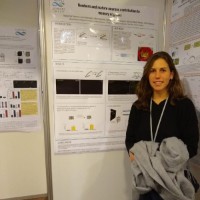Memories are believed to be encoded by memory traces or engrams, represented within subsets of neurons that are synchronously activated during learning. The hippocampus is a brain region required for learning, memory and spatial coding. The input region of the hippocampus, the dentate gyrus (DG), plays a major role in these processes and generates new adult-born granule cells (abGCs) throughout life. However, the participation of these neurons in memory engrams remains unclear. Here we investigated abGCs and mature granule cells (mGCs) contribution to an enriched environment (EE) engram. On day one we injected tamoxifen to express Tomato in abGCs using double transgenic cfostTA; Ascl1CreERT2; CAGFloxStopTom mice. An AAV9-TRE-GFP was then used to label activated neurons in the DG. Temporal control over GFP expression was achieved by administering an on-Dox diet. Mice were taken off-Dox 4 weeks after tamoxifen injection and 48 hs prior to EE exposure. Our preliminary results showed that the proportion of activated abGCs after EE was higher than the proportion of mGCs activation, implying that newborn neurons are strongly activated after contextual encoding. To further evaluate the contribution of abGCs to other hippocampal-dependent behaviors, we are conducting experiments training mice to perform a GO/NO GO discrimination task in a virtual reality environment. These experiments will shed light on the contribution of newborn neurons to contextual memory engrams.
P#122
Involvement of newborn and mature granule cells in contextual memory engrams.
Maria Sol Ramos
- CABA,
- Argentina
- María Sol Ramos ¹
- , Lucía Rodriguez ¹
- , Mora Ogando ¹
- , Macarena Amigo Durán ¹
- , Sebastian Alejo Romano ¹
- , Antonia Marin Burgin ¹
- , Noel Federman ¹
- 1 Instituto de Investigación en Biomedicina de Buenos Aires (IBioBA) – CONICET - Partner Institute of the Max Planck Society

